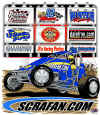


|
Traditional Sprint Car FanSite |
See You At The Races!!! |
| The CASA Chronicles (No. 1) By Glenn Hopper |
|
|
|
KEEPING UP WITH THE CALIFORNIA ASPHALT SPRINTCAR ASSOCIATION |
|
September
6, 2003 As
the California Asphalt Sprintcar Association (CASA) winds down its impressive
inaugural season, some noteworthy things have happened to date. In
the beginning... Last
winter a small group of sprint car racers, discussed the state of California
pavement racing, from its rich history, to its future possibilities. Most of the
discussion emanated from Mike McCreary’s Oval Chassis Research shop in
Placerville, California and the racers involved ranged from 20-plus year
veterans to eager rookies - yet a common thread was discovered. All participants
were concerned with establishing a central locale, which would minimize
excessive, expensive travel and bring back a fun, “home track” weekly show
atmosphere. Many participants fondly remembered the weekly tracks that made up
so much of their lives. The legendary San Jose Speedway, West Capital Raceway,
and NARC’s long-lost pavement action were constantly referenced during the
conversations. Many had just completed the 2002 season running a variety of
shows and tracks with USAC and at Carson City’s Champion Speedway. Another
common thread was also noted. There were roughly 35 pavement cars based in the
San Francisco Bay Area, the Sacramento/Upper San Joaquin Valley and the Gold
Country/Carson Valley. While some of them occasionally traveled to far off
venues in Washington, Idaho, Utah, Colorado and others, continued long-tow
racing was just not feasible from a financial or time standpoint. An
extensive phone campaign was launched by Scott Clough and McCreary to see what
kind of support could be generated for a central California based pavement
series. The results were encouraging and the duo headed to the Racing Promotion
Workshop meetings in Reno, Nevada armed only with a detailed database of
interested racers and the fledgling club’s, “home-oriented” name, CASA. Willing
to negotiate nearly any kind of deal to get things rolling, they did find a few
interested promoters. However, Dennis Ortolan and Andy Herbst of Altamont
Raceway Park were most intrigued by the idea of hosting sprint cars on their
big, fast half-mile. Within 100 miles of most everyone on CASA’s list,
Altamont could be reached by most competitors in just a couple hours. A February
meeting was hosted in the Altamont VIP suite with nearly every likely racer in
attendance. Base issues were discussed, formats established and USAC 360 specs
were adopted to qualify the largest number of available cars. Eleven races were
placed on the schedule, generally spaced in a bi-weekly manor. Options of
running other tracks were shelved until later as the members decided it best to
concentrate on the opportunities provided by Altamont and grow the organization
carefully. Determined
to make good on a worthy car count, McCreary’s OCR shop became “race
central” in the days leading up to the March 22nd opener. No fewer than 7 cars
were prepared at OCR. Much of the progress was overlapping and much of the work
done on one car was completed by the drivers and crews of another competitor.
Engines were installed, body work completed, and set-ups shared- all with a
common goal and spirit. Eleven
cars represented CASA in the inaugural event. Any questions as to CASA’s
legitimacy were immediately and soundly answered. Kenny Rines posted fast time
at 17.762, a scant half-second off reigning Winston Cup Champion Tony
Stewart’s track record. The CASA cars were fast, professional, and raced an
entirely caution-free evening. Green-to-checkered flag events were run in the 2
heats, the dash and in the exciting 30 lap main event, won by Brian Bullard, in
which all racers seemed to be engaged in passing, challenging for position, or
lapping another car throughout the entire distance. CASA and Altamont were off
and running! Future
CASA Chronicles will review the growth of the club, including series sponsorship
updates, driver roster expansion, insight into operations, and driver/member
profiles. Stay
tuned to the future of West Coast pavement sprint car action, the California
Asphalt Sprintcar Association! |
